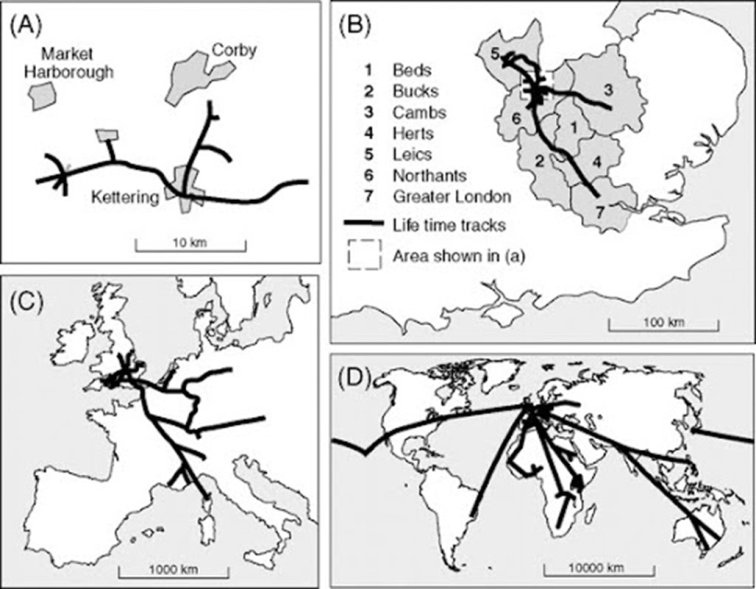III.2. The emergence of sport tourism
Travelling in order to gain new experiences has always been present in societies, although at varying degree. Examples include travles aimed at getting acquainted with other cultures, ‘miracles’, travels with the aim of treating certain medical conditions. In the Middle Ages young apprentices also travelled a lot. The origin of sport tourism goes back to the Ancient times, i.e. the time of the first Olympic Games, when the given city-state was visited by sportsmen or spectators with the aim of participating in the Games or watching its events (Kiss 2013). Today, due to the modern technological development, social space has enlerged and the spatial mobility of people has greatly increased.
Haggett (2006) demonstrates very clearly the ‘fall’ of time and space. (Figure 1.): the great grandfather of the well-known epidemiologist, Bradley, D. J. travelled in his lifetime within a square of 40x40 kms. (A). The travels of the grandfather took place in the southern part of England, and he roughly covered a square of 400x400 kms.His father already travelled extensively in Europe, (4000x4000 km)s, while Bradley himself already travelled around the world. (40000x40000 km). So, the distance covered by each gerneration was constantly growing and between Bradley and his great-grandfather it by one thousand. (!).

Figure 1. The ’fall’ of space and time. Source: Haggett 2006
At the same time technological development – it is a well-known fact – influenced people’s natural surroundings and health in a negative way. Paradoxically, it makes a modern person to leave his place of residence and seek the long-lost features of his surroundings elsewhere. He has to become a tourist in order to enjoy nature’s beauty, wealth and challenges and all these experiences make it possible for him to return home enriched and refreshed..
The word tourism was first mentioned in 1811 by the Oxford English Dictionary, as a derivative of the Englsi word ’tour’, meaning journey, travel in a specific area. The first official definition of the word goes back to 1937 (League of Nations): it was then used to mean a visit to a place other than one’s place of residence for longer than 24 hours. Later thoae people who went for a period shorter than 24 hours were called hikers. Our modern definition is much stricter and the length of time of visit plays a less significant role in it, buti t is important, that the travel as well as the activities be chosen by the individual tourist. Another important motivation is looking for novel experiences and adventures.
The World Tourism Organization and the Interparliamentary Union in 1989 approved of the so-called Hague Declaration on Tourism. It defines tourism as follows. „It encompasses all free movements of persons away from their places of residence and work, as well as the service industries created to satisfy the needs resulting from these movements; (b) It constitutes an activity essential to the lives of human beings and modern societies, having become an important form of using the free time of individuals and the main vehicle for interpersonal relations and political, economic and cultural contact made necessary by the internationalization of all sectors of the life of nation.’ Tourism can be divided into two parts: (1) professional tourism , which is related to one’s own work, and (2) leisure time tourism szabadidős turizmus, a szabadidőben végzett és szabadon választott tevékenysége which is based on free time activities.
Bővebben. http://tavokt.kodolanyi.hu/ifodemo/vendeglato/vendeg_lecke02.htm
By the second half of the 20th century people’s leisure time behavior has changed significantly. As a result, the socio-economic importance of sport has increased significantly.
Bővebben. http://unipub.lib.uni-corvinus.hu/201/2/Szabo115.pdf
The number of travels aimed at doing/being engaged in some sport activity has dramatically increased since the early 1980s. Sport has become a term of complexity rather than simply the sum of physical activities. The time people spend on money making activity has decreased, discretional incomes have been on the rise, recreational habits have changed, people have become more and more health conscious, and the idea of ‘ sport for all’ has become increasingly popular. These features – as a response to the harmful effects of urbanization - have contributed to the growth in the number of people doing sport, especially health-related types of sport. As we have seen, due to an increase in free time, a form of sport has emerged, which is aimed at preserving health and promoting fitness and exercise. Accomplishments are not important, the recreational aim is of primary significance instead. (Szabó 2009).
On the other hand, in the opinion of Hinch and Higham (2001) competition has become decisive in all segments of sport including recreational and first-class sport as well. Sport events related to amateur and professional sport are tourism products as well and as such, they have become very important, too. The number of supporters, present at exhibition-type mega-events, continental championships, leagues and cups have been steadily on the rise. There is also a demand for mass events including street running events, bicycle tours, lake swims etc. In addition to the above, extreme sports are becoming more and more popular, too. (Hall 1992).
As a result of these new tendencies by the 1990s certain governments started to elaborate strategies in the area of sport tourism and they organized mega-events, too.. „Due to these developments, as it was stated by the WTO, sport tourism was the most tapidly developing branch of tourism, occasionally producing 8-10% ghrowth annually. (Kiss 2013, p. 9.)”. This development was supported by some technological development, which made transport faster and easier. Thus the spatial mobility of the population intensified., a trend, which can be seen int he growth of travels aimed at some sport activity. This tendency was only experienced in countries and regions with the most developed economy, in welfare societies, where the most significant challenge was not related to life from hand to mouth, but where peopel aim at living an interesting and rewarding life.